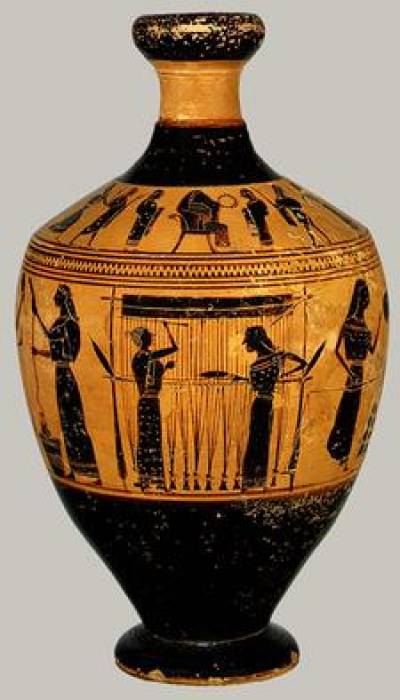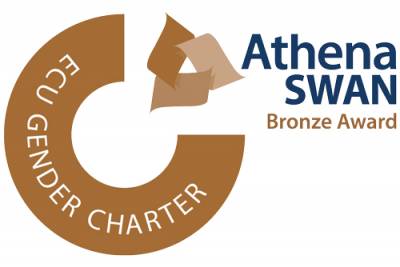Aristophanes, the great comic dramatist of Athens, wrote the Lysistrata for performance in February 411 BC, probably at the Lenaia. The play was written against the backdrop of the final years of the Peloponnesian War (a long and destructive war between Athens and Sparta): Athens had suffered major military setbacks, and shortly after the performance of the play there was an anti-democratic coup in the city which installed a brutal oligarchic regime (the historical background is given in Thucydides' History, book 8).
Stage action in Lysistrata, by Professor Chris Carey
Aristophanes was first and foremost a dramatist. Though we (mostly) meet him on the page, he wrote with live theatre and a live (and demanding) audience in mind. This is true of tragedy as well as comedy. But Athenian comedy is in many ways a far more physical medium than tragedy. Even when we are reading, we need always to bear in mind the staging invited by the text.
Lysistrata is a wonderful play for the stage. The theme itself is a director's gift, because it deals in big confrontations, pits male and female, peace and war against each other. But the way the author approaches the staging itself pulls these issues together impressively.
Aristophanes' theatre was from a modern perspective minimalist. Scenery was limited, lighting non-existent, technology confined to the crane and the ekkyklema, the trolley (we think) used to draw indoor tableaux into the acting space. But for a creative writer-director theatre is medium of communication, not just a set of physical structures and dramatic conventions; and it is a medium which presents opportunities rather than limitations.
I start with props, stage objects used or carried by the characters or just located in dramatic space. The play with props begins right at the start of the play, with the oath swearing. This is a wonderful intertextual moment. The women in swearing to create peace sacrifice wine into a shield. This is of course at one level a typical Aristophanic joke about female drunkenness of a sort which crops up elsewhere in comedy. But Aristophanic jokes are often multi-layered and for anyone who knows their Aeschylus this scene also invites comparison with a moment in one of the (by now) classics war plays, Aeschylus' Seven Against Thebes. The messenger who comes to tell the protagonist Eteocles about the enemy at the gates (42ff.) describes how the enemy make a blood sacrifice into a shield. So there is a nice allusion to and inversion of a moment in the tragic theatre. But the scene goes beyond humour and intertextual allusion to encapsulate the themes of the play. It juxtaposes the most conspicuous (and the heaviest) item of the soldier's equipment, and therefore the embodiment of war, with one of the staples of peace in Aristophanes, wine, which represents leisure, pleasure and relaxation. In this way the props become not just useful visual components in the play but also a means of expressing and reinforcing its themes.

An equally creative use of props can be seen in the entry of the chorus. The chorus of Lysistrata is one of Aristophanes' most brilliant creations. The comic chorus of 24 was much easier to subdivide than the tragic chorus, since it still kept the impression of mass even when split in two. Here he divides it between male and female, so that the chorus itself enacts in its own person the division between the sexes which lies at the heart of the play. And in having a male chorus committed to war and a female chorus committed to peace he aligns the sexes on either side of the main political faultline in the play, war and peace. He further underscores this with the contrasting entrances of the choruses, a male chorus which comes lumbering in, burdened by the bundles of wood they carry and a female chorus which comes rushing in to counter them. But each of the half-choruses comes bearing opposing objects. The men come burdened by bundles of wood, with which they propose to burn the women out of the Acropolis. The women come straight from the fountains carrying pitchers of water. The two choruses are identified with contrasting elements, fire and water, which neatly express the division between the sexes at its most stark. But more than that. In Greek thinking as in modern love and desire are associated with fire. The males throughout the play are starved of sex and the fire graphically expresses the unsatisfied lust which the women have caused and which will ultimately lead to the end of the war. At the same time, it is the job of the women to resist male passion; and this finds its physical expression in the quenching water which they carry. The contrast reaches its climax when the women douse the men with their water, putting out the fire, a gesture which cements the women's victory in this first encounter and at the same time reflects the success of the female resistance to male desire.
One of the most inspired features of the staging is the use of the stage building, which formed the standing backdrop to Athenian plays. The stage building is a very versatile resource, which plays a variety of roles, often a palace in tragedy, the rustic hut in Euripides' Electra, a private house or street in comedy, the Pnyx where the Assembly met in Acharnians. In this play Aristophanes makes it represent the Propylaea, the monumental gateway to the Acropolis and one of the enduring symbols of Athenian strength. Lysistrata's grand plan has two strands. The younger women are to stage the sex strike at home, simultaneously provoking and resisting their husbands, while the older women seize the Acropolis to gain control of the treasure housed there, which can fund and so prolong the war. Despite the fact that this is the plan which Lysistrata announces at the start of the play, Aristophanes makes a subtle switch. He puts his older women not in the Acropolis but in front of it as one half of the chorus occupying the orchestra and has the younger women on the Acropolis. The private sex strike at home is sidelined. This is in part because it would be both difficult and repetitive to stage a series of private acts of sexual temptation and resistance. But the option he has chosen also gives him the opportunity for visually and thematically more impressive clashes between the women and the collective power both of the male sex of civic authority. And he still gets to stage one typical scene later on when Myrrhine leaves the Acropolis ostensibly to satisfy but actually to tease her husband. But by astute use of the stage building he is able to pull together his two plot strands, the seizure of the Acropolis and the sex strike. Behind the orchestra and facing the audience is a closed gateway held by the women which the men are desperately trying to penetrate. The stage set thus becomes a visual metaphor for the sex strike at the heart of the action.
Aristophanes is very fond of this kind of visual metaphor. Part of this is just the comic poet's inventive and witty love of the concrete. Abstract ideas are turned into objects, people, actions, sometimes with paradoxical, occasionally bizarre, effects. But this process can also be used to simplify the comic world and make the impossible possible. This true of my last instance of effective staging. Peace in the real world comes about by negotiation, a combination of hard bargaining and command of detail. This is fascinating for the diplomat and the historian. But it may not always make for lively comedy, certainly not in a comic theatre which likes grand figures and grand gestures, like this one. Negotiation also takes time. All of Aristophanes' peace plays offer neat solutions to this problem, all different. In Lysistrata peace is brought about by the figure of Reconciliation, a naked woman (that is, a male actor in a costume representing a naked woman). The Athenian and Spartan negotiators argue over her body, each part of which (by the kind of punning Aristophanes loves) corresponds to different parts of Greece. It's a metaphor for carving up the map which mimics territorial negotiations in a comically grotesque way. But as well as offering a neat way to move rapidly from war (both in Greece and between the sexes) to peace this scene also pulls together many of the key elements of the play. The female is Reconciliation; so she embodies the end of the war. Her gender places her with the victorious females; and her sexuality, together with the desperate yearning of the negotiators, re-enacts the strategy with which the women won the day. The connection between sex and peace is as strong in Aristophanes as that between wine and peace. Both belong to a world of leisure. This is all good fun. It is also theatrically clever and shows a writer-director supremely in control of his medium. (© Professor Chris Carey)
Vase: Attributed to the Amasis Painter (Attic black-figure lekythos, ca. 550-530 BC). In Heilbrunn Timeline of Art History. New York: The Metropolitan Museum of Art, 2000 (more information)
Study questions
1. Are male and female characters treated differently in the play? Does Aristophanes reinforce contemporary stereotypes about women?
2. Do obscene jokes, nudity, phalluses etc need to be 'toned down' for a modern audience?
3. Lysistrata is unique in surviving comedy in having two choruses. What is the role of the choruses in the play?
4. Are current events critical to an understanding the play?
5. Aristophanic comedy is often described as a realistic genre; and yet the plays contain large elements of fantasy. How does this work in Lysistrata?
Modern productions
- The Happiest Girl in the World (1961 Broadway musical): music from Offenbach
- Screening at the Getty 2009 (three films and notes)
Further Reading
Translations
• Translation of Lysistrata, Acharnians, Clouds (with introduction and notes): Lysistrata and Other Plays translated by A.H. Sommerstein (Penguin 2003)
• K.J. Dover & S. Tremewan, Aristophanes Clouds, Acharnians, Lysistrata. A Companion to the Penguin Translation of A.H.Sommerstein (Bristol 1991)
General works of criticism
P. Cartledge, Aristophanes and his Theatre of the Absurd (Bristol 1990)
K.J. Dover, Aristophanic Comedy (Berkeley 1972)
K. McLeish, The Theatre of Aristophanes (London 1980)
K. Sidwell, Aristophanes the Democrat (Cambridge 2009)
D. Stuttard, Looking at Lysistrata: Eight Essays and a New Version of Aristophanes' Provocative Comedy (Bristol 2010)
Aristophanes in the modern world
E. Hall and A. Wrigley (eds.), Aristophanes in Performance 421 BC- AD 2007: Peace, Birds and Frogs (London 2007)
G. Van Steen, Venom in Verse: Aristophanes in Modern Greece (Princeton 2000)
Useful websites
 Close
Close



